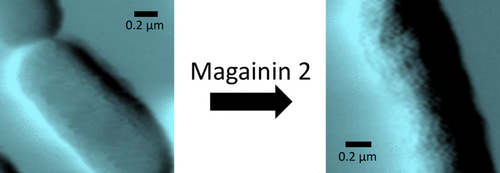Our official English website, www.x-mol.net, welcomes your
feedback! (Note: you will need to create a separate account there.)
Qualitative and Quantitative Changes to Escherichia coli during Treatment with Magainin 2 Observed in Native Conditions by Atomic Force Microscopy.
Langmuir ( IF 3.7 ) Pub Date : 2020-01-08 , DOI: 10.1021/acs.langmuir.9b02726 Kanesha Overton 1 , Helen M Greer 1 , Megan A Ferguson 2 , Eileen M Spain 3 , Donald E Elmore 4 , Megan E Núñez 4 , Catherine B Volle 1
Langmuir ( IF 3.7 ) Pub Date : 2020-01-08 , DOI: 10.1021/acs.langmuir.9b02726 Kanesha Overton 1 , Helen M Greer 1 , Megan A Ferguson 2 , Eileen M Spain 3 , Donald E Elmore 4 , Megan E Núñez 4 , Catherine B Volle 1
Affiliation

|
The bacterial membrane has been suggested as a good target for future antibiotics, so it is important to understand how naturally occurring antibiotics like antimicrobial peptides (AMPs) disrupt those membranes. The interaction of the AMP magainin 2 (MAG2) with the bacterial cell membrane has been well characterized using supported lipid substrates, unilamellar vesicles, and spheroplasts created from bacterial cells. However, to fully understand how MAG2 kills bacteria, we must consider its effect on the outer membrane found in Gram-negative bacteria. Here, we use atomic force microscopy (AFM) to directly investigate MAG2 interaction with the outer membrane of Escherichia coli and characterize the biophysical consequences of MAG2 treatment under native conditions. While propidium iodide penetration indicates that MAG2 permeabilizes cells within seconds, a corresponding decrease in cellular turgor pressure is not observed until minutes after MAG2 application, suggesting that cellular homeostasis machinery may be responsible for helping the cell maintain turgor pressure despite a loss of membrane integrity. AFM imaging and force measurement modes applied in tandem reveal that the outer membrane becomes pitted, more flexible, and more adhesive after MAG2 treatment. MAG2 appears to have a highly disruptive effect on the outer membrane, extending the known mechanism of MAG2 to the Gram-negative outer membrane.
中文翻译:

在自然条件下通过原子力显微镜观察到的用Magainin 2处理过程中大肠杆菌的质和量变化。
细菌膜被认为是未来抗生素的良好靶标,因此了解诸如抗生素肽(AMPs)等天然存在的抗生素如何破坏这些膜是很重要的。AMP magainin 2(MAG2)与细菌细胞膜的相互作用已通过使用支持的脂质底物,单层囊泡和由细菌细胞产生的原生质球很好地表征。但是,要完全了解MAG2是如何杀死细菌的,我们必须考虑其对革兰氏阴性细菌外膜的影响。在这里,我们使用原子力显微镜(AFM)直接研究MAG2与大肠杆菌外膜的相互作用,并表征在自然条件下MAG2处理的生物物理后果。尽管碘化丙啶的渗透表明MAG2在几秒钟内就使细胞通透,但直到MAG2施用后几分钟,才观察到细胞膨胀压力的相应降低,这表明尽管细胞膜完整性受损,细胞稳态机制仍可能有助于细胞维持膨胀压力。串联应用的AFM成像和力测量模式显示,经过MAG2处理后,外膜变得有凹痕,更具柔韧性和粘性。MAG2似乎对外膜具有高度破坏性的作用,从而将MAG2的已知机理扩展到革兰氏阴性外膜。这表明尽管细胞膜完整性受损,细胞稳态机制仍可能有助于维持细胞的膨大压力。串联应用的AFM成像和力测量模式显示,经过MAG2处理后,外膜变得有凹痕,更具柔韧性和粘性。MAG2似乎对外膜具有高度破坏性的作用,从而将MAG2的已知机理扩展到革兰氏阴性外膜。这表明尽管细胞膜完整性受损,细胞稳态机制仍可能有助于维持细胞的膨大压力。串联应用的AFM成像和力测量模式显示,经过MAG2处理后,外膜变得有凹痕,更具柔韧性和粘性。MAG2似乎对外膜具有高度破坏性的作用,从而将MAG2的已知机理扩展到革兰氏阴性外膜。
更新日期:2020-01-08
中文翻译:

在自然条件下通过原子力显微镜观察到的用Magainin 2处理过程中大肠杆菌的质和量变化。
细菌膜被认为是未来抗生素的良好靶标,因此了解诸如抗生素肽(AMPs)等天然存在的抗生素如何破坏这些膜是很重要的。AMP magainin 2(MAG2)与细菌细胞膜的相互作用已通过使用支持的脂质底物,单层囊泡和由细菌细胞产生的原生质球很好地表征。但是,要完全了解MAG2是如何杀死细菌的,我们必须考虑其对革兰氏阴性细菌外膜的影响。在这里,我们使用原子力显微镜(AFM)直接研究MAG2与大肠杆菌外膜的相互作用,并表征在自然条件下MAG2处理的生物物理后果。尽管碘化丙啶的渗透表明MAG2在几秒钟内就使细胞通透,但直到MAG2施用后几分钟,才观察到细胞膨胀压力的相应降低,这表明尽管细胞膜完整性受损,细胞稳态机制仍可能有助于细胞维持膨胀压力。串联应用的AFM成像和力测量模式显示,经过MAG2处理后,外膜变得有凹痕,更具柔韧性和粘性。MAG2似乎对外膜具有高度破坏性的作用,从而将MAG2的已知机理扩展到革兰氏阴性外膜。这表明尽管细胞膜完整性受损,细胞稳态机制仍可能有助于维持细胞的膨大压力。串联应用的AFM成像和力测量模式显示,经过MAG2处理后,外膜变得有凹痕,更具柔韧性和粘性。MAG2似乎对外膜具有高度破坏性的作用,从而将MAG2的已知机理扩展到革兰氏阴性外膜。这表明尽管细胞膜完整性受损,细胞稳态机制仍可能有助于维持细胞的膨大压力。串联应用的AFM成像和力测量模式显示,经过MAG2处理后,外膜变得有凹痕,更具柔韧性和粘性。MAG2似乎对外膜具有高度破坏性的作用,从而将MAG2的已知机理扩展到革兰氏阴性外膜。











































 京公网安备 11010802027423号
京公网安备 11010802027423号